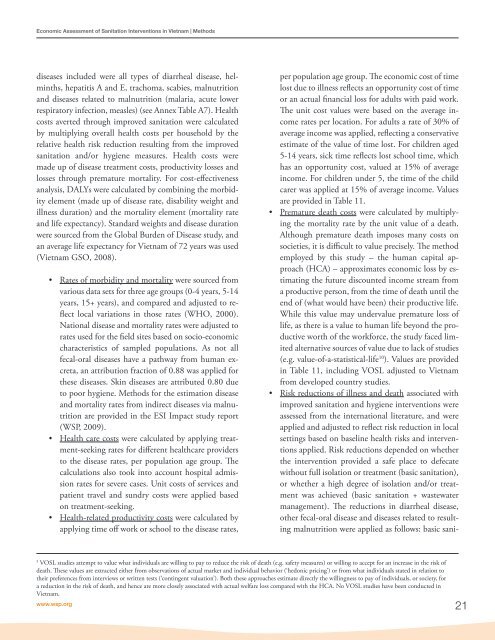Economic Assessment of Sanitation Interventions in Vietnam - WSP
Economic Assessment of Sanitation Interventions in Vietnam - WSP
Economic Assessment of Sanitation Interventions in Vietnam - WSP
You also want an ePaper? Increase the reach of your titles
YUMPU automatically turns print PDFs into web optimized ePapers that Google loves.
<strong>Economic</strong> <strong>Assessment</strong> <strong>of</strong> <strong>Sanitation</strong> <strong>Interventions</strong> <strong>in</strong> <strong>Vietnam</strong> | Methodsdiseases <strong>in</strong>cluded were all types <strong>of</strong> diarrheal disease, helm<strong>in</strong>ths,hepatitis A and E, trachoma, scabies, malnutritionand diseases related to malnutrition (malaria, acute lowerrespiratory <strong>in</strong>fection, measles) (see Annex Table A7). Healthcosts averted through improved sanitation were calculatedby multiply<strong>in</strong>g overall health costs per household by therelative health risk reduction result<strong>in</strong>g from the improvedsanitation and/or hygiene measures. Health costs weremade up <strong>of</strong> disease treatment costs, productivity losses andlosses through premature mortality. For cost-effectivenessanalysis, DALYs were calculated by comb<strong>in</strong><strong>in</strong>g the morbidityelement (made up <strong>of</strong> disease rate, disability weight andillness duration) and the mortality element (mortality rateand life expectancy). Standard weights and disease durationwere sourced from the Global Burden <strong>of</strong> Disease study, andan average life expectancy for <strong>Vietnam</strong> <strong>of</strong> 72 years was used(<strong>Vietnam</strong> GSO, 2008).• Rates <strong>of</strong> morbidity and mortality were sourced fromvarious data sets for three age groups (0-4 years, 5-14years, 15+ years), and compared and adjusted to reflectlocal variations <strong>in</strong> those rates (WHO, 2000).National disease and mortality rates were adjusted torates used for the field sites based on socio-economiccharacteristics <strong>of</strong> sampled populations. As not allfecal-oral diseases have a pathway from human excreta,an attribution fraction <strong>of</strong> 0.88 was applied forthese diseases. Sk<strong>in</strong> diseases are attributed 0.80 dueto poor hygiene. Methods for the estimation diseaseand mortality rates from <strong>in</strong>direct diseases via malnutritionare provided <strong>in</strong> the ESI Impact study report(<strong>WSP</strong>, 2009).• Health care costs were calculated by apply<strong>in</strong>g treatment-seek<strong>in</strong>grates for different healthcare providersto the disease rates, per population age group. Thecalculations also took <strong>in</strong>to account hospital admissionrates for severe cases. Unit costs <strong>of</strong> services andpatient travel and sundry costs were applied basedon treatment-seek<strong>in</strong>g.• Health-related productivity costs were calculated byapply<strong>in</strong>g time <strong>of</strong>f work or school to the disease rates,per population age group. The economic cost <strong>of</strong> timelost due to illness reflects an opportunity cost <strong>of</strong> timeor an actual f<strong>in</strong>ancial loss for adults with paid work.The unit cost values were based on the average <strong>in</strong>comerates per location. For adults a rate <strong>of</strong> 30% <strong>of</strong>average <strong>in</strong>come was applied, reflect<strong>in</strong>g a conservativeestimate <strong>of</strong> the value <strong>of</strong> time lost. For children aged5-14 years, sick time reflects lost school time, whichhas an opportunity cost, valued at 15% <strong>of</strong> average<strong>in</strong>come. For children under 5, the time <strong>of</strong> the childcarer was applied at 15% <strong>of</strong> average <strong>in</strong>come. Valuesare provided <strong>in</strong> Table 11.• Premature death costs were calculated by multiply<strong>in</strong>gthe mortality rate by the unit value <strong>of</strong> a death.Although premature death imposes many costs onsocieties, it is difficult to value precisely. The methodemployed by this study – the human capital approach(HCA) – approximates economic loss by estimat<strong>in</strong>gthe future discounted <strong>in</strong>come stream froma productive person, from the time <strong>of</strong> death until theend <strong>of</strong> (what would have been) their productive life.While this value may undervalue premature loss <strong>of</strong>life, as there is a value to human life beyond the productiveworth <strong>of</strong> the workforce, the study faced limitedalternative sources <strong>of</strong> value due to lack <strong>of</strong> studies(e.g. value-<strong>of</strong>-a-statistical-life 10 ). Values are provided<strong>in</strong> Table 11, <strong>in</strong>clud<strong>in</strong>g VOSL adjusted to <strong>Vietnam</strong>from developed country studies.• Risk reductions <strong>of</strong> illness and death associated withimproved sanitation and hygiene <strong>in</strong>terventions wereassessed from the <strong>in</strong>ternational literature, and wereapplied and adjusted to reflect risk reduction <strong>in</strong> localsett<strong>in</strong>gs based on basel<strong>in</strong>e health risks and <strong>in</strong>terventionsapplied. Risk reductions depended on whetherthe <strong>in</strong>tervention provided a safe place to defecatewithout full isolation or treatment (basic sanitation),or whether a high degree <strong>of</strong> isolation and/or treatmentwas achieved (basic sanitation + wastewatermanagement). The reductions <strong>in</strong> diarrheal disease,other fecal-oral disease and diseases related to result<strong>in</strong>gmalnutrition were applied as follows: basic sani-5VOSL studies attempt to value what <strong>in</strong>dividuals are will<strong>in</strong>g to pay to reduce the risk <strong>of</strong> death (e.g. safety measures) or will<strong>in</strong>g to accept for an <strong>in</strong>crease <strong>in</strong> the risk <strong>of</strong>death. These values are extracted either from observations <strong>of</strong> actual market and <strong>in</strong>dividual behavior (‘hedonic pric<strong>in</strong>g’) or from what <strong>in</strong>dividuals stated <strong>in</strong> relation totheir preferences from <strong>in</strong>terviews or written tests (‘cont<strong>in</strong>gent valuation’). Both these approaches estimate directly the will<strong>in</strong>gness to pay <strong>of</strong> <strong>in</strong>dividuals, or society, fora reduction <strong>in</strong> the risk <strong>of</strong> death, and hence are more closely associated with actual welfare loss compared with the HCA. No VOSL studies have been conducted <strong>in</strong><strong>Vietnam</strong>.www.wsp.org21
















